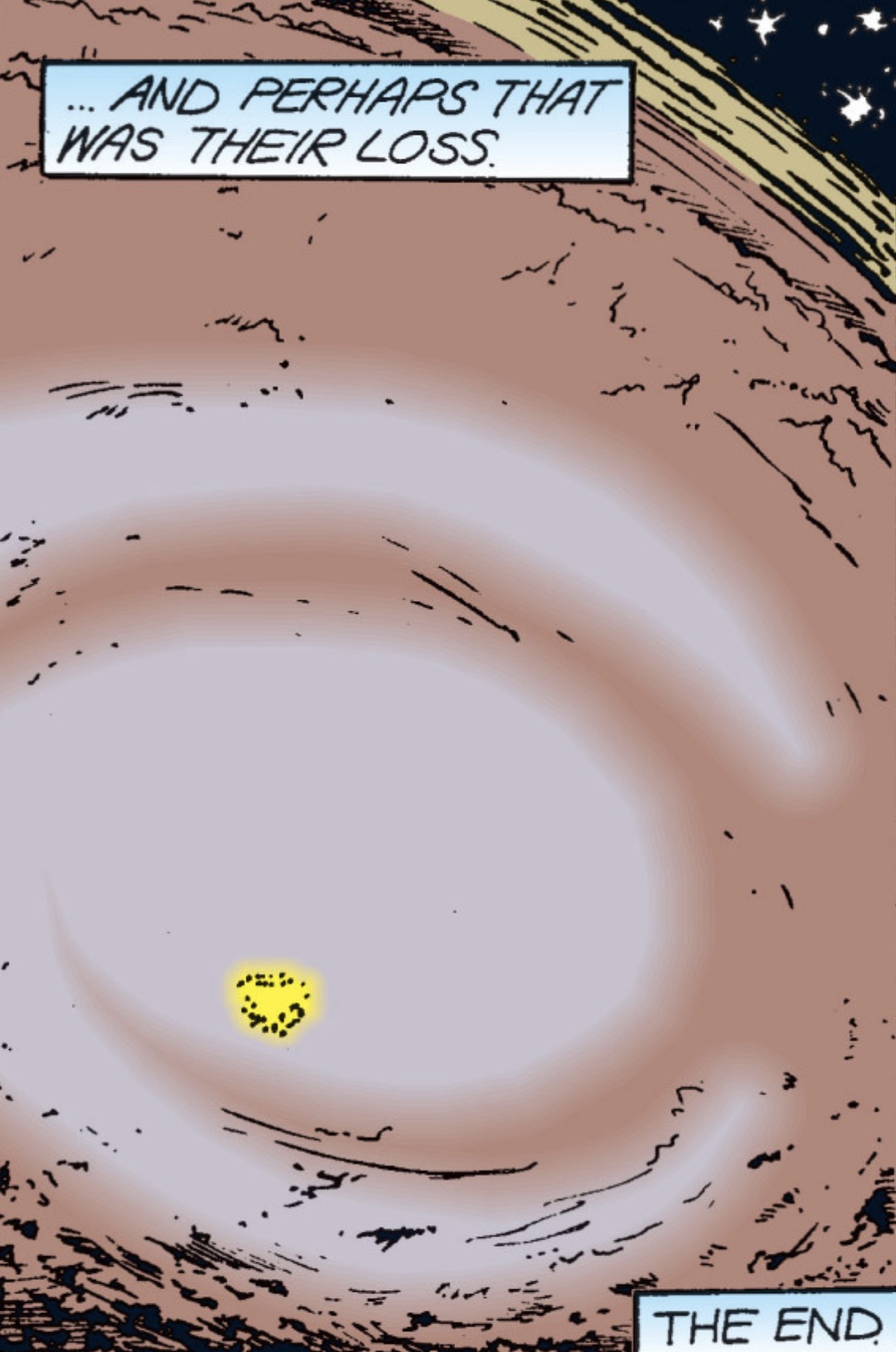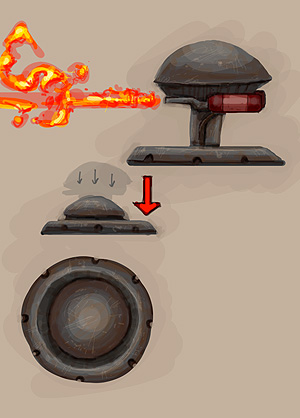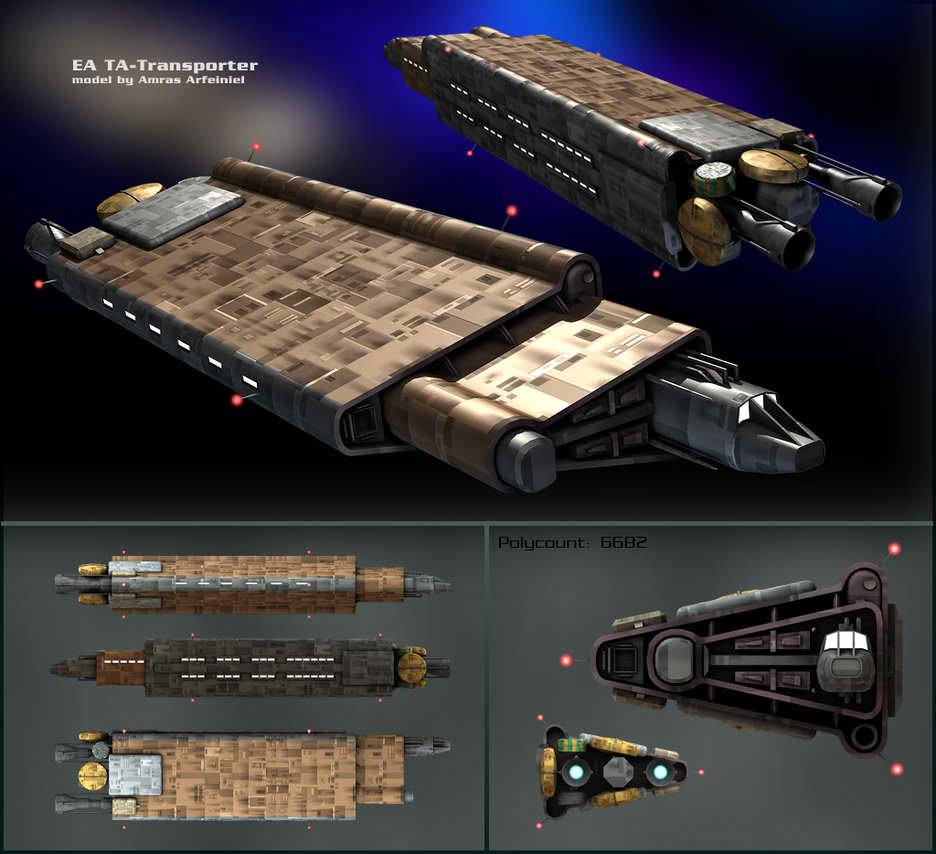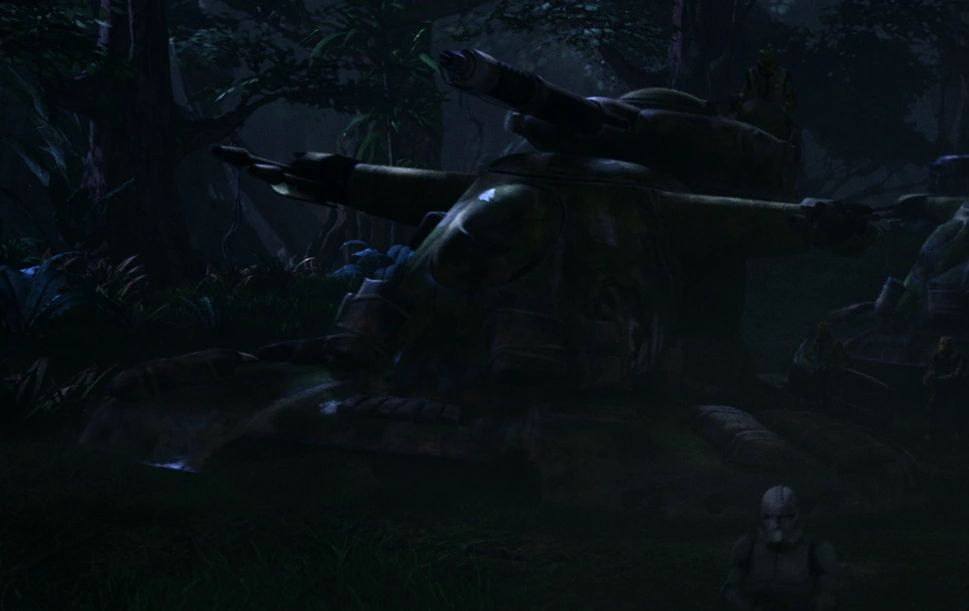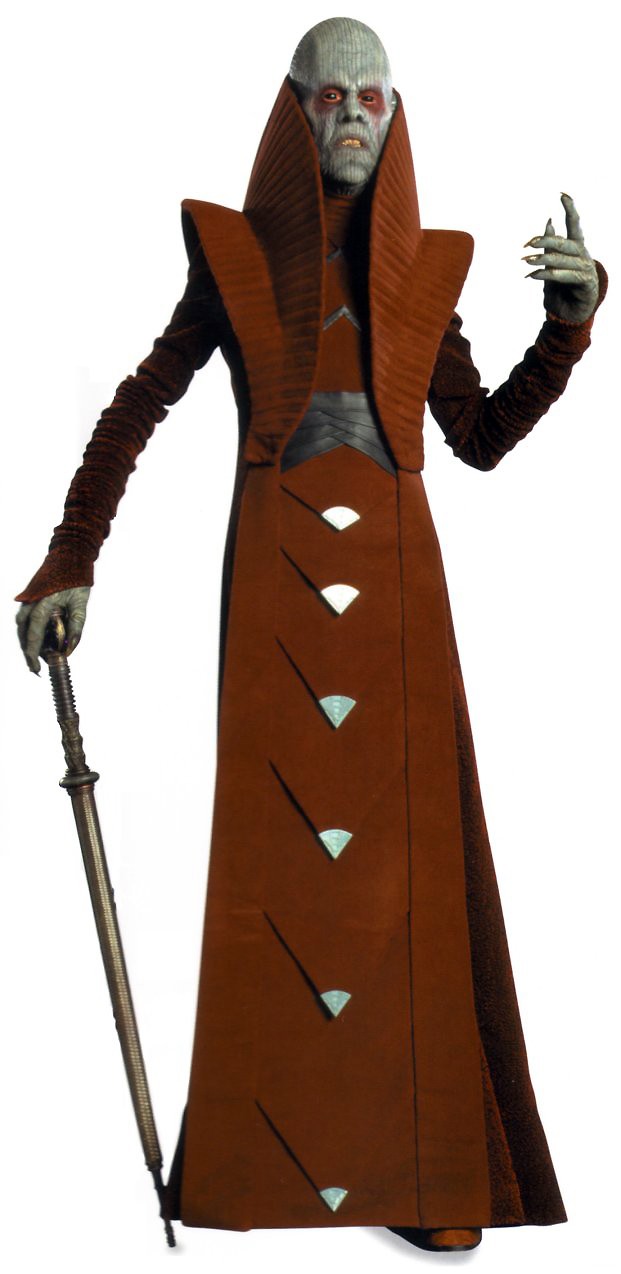 Name: Pauan
Attribute Dice: 12D
Dex: 2D/4D
Know: 2D/4D
Mech: 2D/4D
Perc: 2D/4D
Str: 2D/4D
Tech: 2D/4D
Special Abilities:
Nightvision:.Members of the species were able to see well in darkness. And all difficulty penalties for low light conditions are lowered by one level.
Story Factors:
Carnivore: Pau'ans have jagged, fang-like teeth used for tearing into raw meat, as they were carnivores.
Long Life: Pau'ans have long lifespans, living up to 700 years.
Distinctions: Bald, long arms and fingers, Red eye sockets, Pinstriped skin, Long lifespan
Skin Colour: Gray
Move: 10/12
Size: 1.9 meters tall
Description: Pau'ans were gaunt near-Humans native to the planet Utapau. Also known as Utapauns and Ancients due to their long lifespans, they co-existed on Utapau with the Utai. The two species got along well, with the lanky Pau'ans assuming leadership roles on the planet. Though some viewed the Pau'ans as frightening, they were friendly, and were more than happy to welcome visitors to their little-known world. Due to Utapau's remoteness in the Outer Rim Territories, the Pau'ans were isolated for most of their history. However, they played a part in galactic events in 19 BBY, when the Confederacy of Independent Systems conquered Utapau. The Pau'ans opposed the Confederacy with the aid of the Republic, and later opposed the Empire, after Imperials took control of their planet following the Declaration of a New Order.
Biology and appearance
The average member of the sentient near-Human Pau'an, or Utapaun, as they were sometime called, species stood taller than a Human, at approximately 1.9 meters. They were bald and their head was striped with furrowed gray skin. Pau'ans weighed seventy kilograms on average. Pau'ans had large, sunken black eyes in red eye sockets and jagged, fang-like teeth used for tearing into raw meat, as they were carnivores. The species had pale, wrinkled skin, due to the fact that they lived in the sinkholes of Utapau, giving them limited access to light. These traits caused some to view them as frightening. However, Pau'ans as a society were generally friendly, and were happy to welcome guests to their often overlooked world. Pau'ans had long lifespans, living up to 700 years, much longer than the Utai, the other species native to Utapau. This earned them the nickname of "Ancients". Members of the species were able to see well in darkness. Pau'ans had five fingers and toes, but were more mobile than they appeared. They often wore elaborate clothes intended to heighten their impressive stature. Most Pau'ans spoke both Utapese and Basic.
Society and culture
The Pau'ans fulfilled most of the governmental and administrative duties on Utapau, as the Utai did not desire such work, serving as laborers instead. Most Pau'ans served as leaders early in their lives, often managing teams of Utai laborers. This gave them experience that would be used later in their life. Pau'ans were kind leaders, and sympathetic to their subordinates. Each city on Utapau was controlled by a Master of Port Administration, a hereditary title reserved for Pau'ans. These administrators were assisted by advisory councils for making important decisions about their city, turning to the Utapauan Security Force when necessary. Each Administrator served on the Utapauan Committee and oversaw planetary governance. However, the committee rarely made crucial decisions, as the cities were able to function on their own most of the time.
Despite the many differences between the Pau'ans and the Utai, the two species were able to co-exist peacefully, although inhabitants of the different Utapaun cities often had conflicts due to philosophical differences. Still, these conflicts rarely developed into bloodshed, and it was more common for the cities to ignore each other. Each city had its own culture, and competition was fierce between the groups. However, they were able to cooperate when the situation necessitated it, such as during the Confederate invasion of the planet in 19 BBY.
Pau'an society was a blend of a variety of styles and cultures, borne from the ancient merger with the Utai. Built into the sinkhole walls, Pau'an settlements such as the Pau City spaceport were divided into different areas, each a mix of architectural styles and other-worldly design. They liked art, and enjoyed studying sculptures and finding ways to incorporate different artistic styles into their architecture. Pau'ans developed an industrial society, despite their seemingly primitive and natural image, though the Utai were the ones who actually did the hard work. The Utai did not mind, however, and collectively much preferred labor to positions of leadership. They were able to power their city by wind, harnessing it through massive windmills. Over ninety-nine percent of the planet's power came from these windmills. Most Pau'ans rode living beasts like varactyls and dactillions instead of speeders. Pau'ans, as well as Utai, were known for their love for Podracing.
Pau'ans represented 30%—or approximately 28.5 million—of Utapau's total population of 90 million inhabitants.
History
Pau'an civilization began around 57,000 BBY. It was believed that settlers traveled to Utapau hoping to find a hospitable world to colonize after the destruction of their homeworld. Some created homes in the sinkholes, while others lived on the surface. Over time, the species changed genetically, becoming the Pau'ans and the Utai, two species with many differences but some similarities. Researchers from the University of Sanbra discovered evidence supporting the theory that the two species were related, although exact specifications were not certain. Eventually, a climate change, causing severe winds, forced the Pau'ans underground, into the sinkholes. The Utai welcomed the Pau'ans, and over time, the two societies merged together to live in a mutually beneficial civilization. Timon Medon was the Pau'an responsible for this, and he was held in high esteem by Pau'ans for his actions. Following the merging of the two cultures, they split into several different groups, forming sinkhole cities scattered across Utapau. Tion Medon, Port Administrator in 19 BBY, was named for Timon Medon. Pau'ans represented only about thirty percent of the population on Utapau, though as the administrators and bureaucrats of the sinkhole cities, their influence made up for their lack of numbers.
Due to trade restrictions placed on them by the Trade Federation, Pau'ans were unable to import many goods such as weapons or starships, and were forced to create their own technology. As Utapau was located in the distant Outer Rim Territories, few independent traders ventured to their planet; although many ventured there around 49 BBY after hearing rumors that the waters on the planet had miraculous healing properties. There were even claims that Utapau was the original home of the Jedi, although these reports were not new; they had originated millennia before. Though the Pau'ans did not want to draw attention to themselves for fear of meeting more powerful cultures who might try to conquer them, they eagerly welcomed visitors who wished to experience the healing for themselves. However, once the water was proven to be nothing more than ordinary water, most people forgot about Utapau, once again leaving it alone.
The Pau'an culture was disturbed during the Clone Wars by the Confederacy of Independent Systems. Though the neutral Utapauns attempted to fight back with several Rendili Star Dreadnaughts, the CIS succeeded in conquering the planet as a stronghold. Administrator Tion Medon and his aide Lampay Fay were forced to host General Grievous and his allies on Utapau, turning the planet into a Separatist safehouse. The Pau'ans hid their starfighters, Porax-38 fighters, so they would not be used by the Separatist war machine or destroyed.
With the arrival of Jedi Master Obi-Wan Kenobi, many Pau'ans and Utai fought back against the droid forces, with the Utai flying their starfighters in an effort to help liberate their planet, though Utapau was subjugated once more with the formation of the Galactic Empire. The Empire used the planet's resources with no thought to the native cultures that were affected, and Pau'an captives were shipped as slaves for several Imperial projects, including the colonization of Byss. Some Pau'ans and Utai created resistance movements, and the different cities were able to unify once more in the face of a great threat.
Following the liberation of their planet by the New Republic, they joined the new galactic government, hoping to avoid further enslavement and poor treatment at the hands of the leaders of the galaxy. Following the Yuuzhan Vong War, the Utapauan Committee elected to join the Galactic Alliance, holding democracy as vital to the preservation of the galaxy. When the Sith Lord Darth Krayt took control of the Galactic Empire, Utapau sheltered Admiral Gar Stazi of the Galactic Alliance Remnant late in the war after having providing the GA fleet shelter throughout the conflict.
Condemning the genocide wrought by the Sith on Dac, Port Administrator Telan Medon of Pau City agreed to harbor Stazi and his wounded men deep in the labyrinthine caves that pocketed the capital. Unbeknownst to the Pau'ans, Sith scientist Vul Isen had established a laboratory on the planet, conducting illegal experiments on the natives. Located within plain sight in one of Pau City's main precincts, the lab's function was to provide Isen a space to concoct a deadly virus that would wipe all life from Utapau indefinitely. Before Isen could unleash the deadly plague, Jedi Knight Cade Skywalker infiltrated the lab and cut Isen down, securing the toxin and saving the Pau'an race from extinction.
Pau'ans in the galaxy
Pau'ans were rarely found on a world other than Utapau, owing mainly to the remoteness of their planet. However, one individual who did achieve notoriety was the Pau'an Darth Desolous, who served as a Jedi prior to his fall to the dark side, when he became a Sith. Born in approximately 3522 BBY, Desolous joined the Jedi Order before being expelled due to his violent tendencies. He turned to the dark side, returned to Utapau, and trained a number of Pau'ans in melee combat. Desolous and his army killed a number of Jedi before he was defeated and killed by the Jedi High Council at Yaga Minor. In another instance, Lar Le'Ung attained the rank of Master within the rebuilt Jedi Order by 25 ABY, only to die at the beginning of the bloody Yuuzhan Vong War.
Pau'ans that left Utapau could be found as aides to nobles and senators. Having Pau'an aides was seen as a status symbol, much like having Caamasi advisors. As the Pau'ans were skilled leaders, some were recruited by the Corporate Sector Authority to work as managers of corporations. At one point, so many Pau'ans were recruited by companies that the CSA had to intervene and force businesses to take only a limited number of Pau'ans to be managers. However, following the rise of the Empire, Pau'ans were mistreated, and the assistants who had formerly enjoyed pleasant, successful lives were mocked and used as slaves.
At least one Pau'an joined the Galactic Empire, serving as an interrogator. This particular Pau'an enjoyed torturing suspects, and would use torture to force them to divulge information. Around 0 ABY, he interrogated Princess Leia Organa, a member of the Rebel Alliance, in an effort to determine the identity of the pilot who had destroyed the Empire's Death Star superweapon. This individual was killed by the assassin X-7 before he could force any information from Organa.
|









